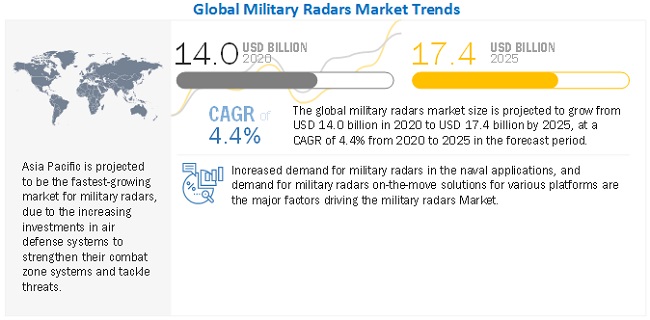Rise in the defense spending of emerging economies, growing regional tensions, and an increasing number of inter-country conflicts are major factors driving the military radars market. The increasing deployment of ballistic and stealth missiles in active war zones has also led to a significant increase in the demand for military radars across the globe.
The global military radars market size is projected to grow from USD 14.0 billion in 2020 to USD 17.4 billion by 2025, at a CAGR of 4.4% during the forecast period. Increasing threats from high-speed missiles and aircraft have led to an increase in demand for surveillance and fire control radars.

The increasing deployment of ballistic and stealth missiles in active war zones has also led to a significant increase in the demand for military radars across the globe. Increasing threats from high-speed missiles and aircraft have led to an increase in demand for surveillance and fire control radars. Rise in the defense spending of emerging economies, growing regional tensions, and an increasing number of inter-country conflicts are major factors driving the military radars market.
Based on application, air & missile defense is estimated to be the largest and fastest-growing segment in the military radars market.Ongoing modernization programs in airspace monitoring in Asia Pacific region, activities such as sea-based military operations, drug trafficking, illegal migrations, demand for early warning threat detection systems, continuous demand for mine detection systems and equipment by US military to tackle conflicts in the Middle East and Asia Pacific will drive the market for air & missile defense radars, globally.
Get All The Further Insights: https://www.marketsandmarkets.com/Market-Reports/military-radar-market-51422570.html
Based on platform segment, the naval platform is estimated to be the largest and fastest-growing segment in the military radars market. The growth of this segment can be attributed to increased efficiency and higher accuracy of ship-based naval radar systems drive this segment. The demand for effective weapon guidance systems for naval ships is boosting the growth of ship-based naval radars. Increasing investments by the Asian countries for the development of ship-based radar systems is further propelling the industry growth. More than half of the global shipbuilding activities are conducted in countries such as China, Japan, and South Korea will drive the market for naval radars.
Based on product type, the surveillance and early airborne warning radar segment is estimated to have the largest market share by value. Ongoing military modernization, replacement of obsolete radars, and introduction of digital signal processing and solid-state modules are additional factors expected to drive the surveillance and early airborne warning radars market during the forecast period. The demand for technologically advanced early airborne warning radar systems is increasing as various major manufacturers from developed countries are developing carefully-shaped fighters which leads to a significant reduction in its detection range.
Based on the region, the Asia Pacific region of the military radars market is projected to grow at the highest CAGR during the forecast period. The growth of this region can be attributed due to the increasing investments in air defense systems to strengthen their combat zone systems and tackle threats. China and India are upgrading their surveillance and resource allocation abilities by upgrading their command and control networks. China is expected to drive the military radars market in Asia Pacific region. Countries such as Vietnam, Thailand, and Australia, who earlier invested in land forces, are now considering to increase their spending in the air-sea defense sector.
Key manufacturers of military radars systems are based in North America. These players include Raytheon Technologies Corporation (US), Lockheed Martin Corporation (US), and among others. These companies have reliable manufacturing facilities as well as strong distribution networks across key regions, such as North America, Europe, and Asia Pacific.
Lockheed Martin Corporation manufactures a variety of radars and sensors, using electro-optical/infrared sensor systems, which provide advanced precision targeting, navigation, threat detection, and next-generation intelligence, surveillance, and reconnaissance capabilities.
Israel Aerospace Industries is a company that manufactures and provides a wide range of products for airborne, naval, and land systems under commercial aviation, defense, and homeland security sectors. The company offers surveillance radars for land, coastal, airborne, and naval applications. Its ground-based radars can be fixed, mobile, or portable, depending on the requirements of users.
Leonardo S.P.A. provides a wide range of defense and security solutions to the government, private, and commercial sectors. The company is known for its investments in research & development across the aerospace, defense, and security sectors. The company has a large supply network, due to the presence of subsidiaries, joint ventures, and international partnerships across 20 countries, including the UK, Poland, and the US.
Get Sample Here: https://www.marketsandmarkets.com/requestsampleNew.asp?id=51422570
About MarketsandMarkets™
MarketsandMarkets™ provides quantified B2B research on 30,000 high growth niche opportunities/threats which will impact 70% to 80% of worldwide companies’ revenues. Currently servicing 7500 customers worldwide including 80% of global Fortune 1000 companies as clients. Almost 75,000 top officers across eight industries worldwide approach MarketsandMarkets™ for their painpoints around revenues decisions.
Our 850 fulltime analyst and SMEs at MarketsandMarkets™ are tracking global high growth markets following the "Growth Engagement Model – GEM". The GEM aims at proactive collaboration with the clients to identify new opportunities, identify most important customers, write "Attack, avoid and defend" strategies, identify sources of incremental revenues for both the company and its competitors. MarketsandMarkets™ now coming up with 1,500 MicroQuadrants (Positioning top players across leaders, emerging companies, innovators, strategic players) annually in high growth emerging segments. MarketsandMarkets™ is determined to benefit more than 10,000 companies this year for their revenue planning and help them take their innovations/disruptions early to the market by providing them research ahead of the curve.
MarketsandMarkets’s flagship competitive intelligence and market research platform, "Knowledgestore" connects over 200,000 markets and entire value chains for deeper understanding of the unmet insights along with market sizing and forecasts of niche markets.
Contact:
Mr. Aashish Mehra
MarketsandMarkets™ INC.
630 Dundee Road
Suite 430
Northbrook, IL 60062
USA : 1-888-600-6441
Comments
Post a Comment